Input interpretation

H_2O water + CaC_2 calcium carbide ⟶ CaO lime + C_2H_2 acetylene
Balanced equation
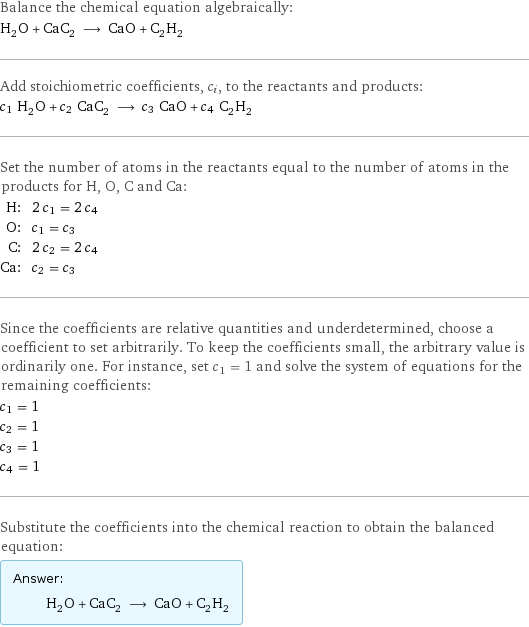
Balance the chemical equation algebraically: H_2O + CaC_2 ⟶ CaO + C_2H_2 Add stoichiometric coefficients, c_i, to the reactants and products: c_1 H_2O + c_2 CaC_2 ⟶ c_3 CaO + c_4 C_2H_2 Set the number of atoms in the reactants equal to the number of atoms in the products for H, O, C and Ca: H: | 2 c_1 = 2 c_4 O: | c_1 = c_3 C: | 2 c_2 = 2 c_4 Ca: | c_2 = c_3 Since the coefficients are relative quantities and underdetermined, choose a coefficient to set arbitrarily. To keep the coefficients small, the arbitrary value is ordinarily one. For instance, set c_1 = 1 and solve the system of equations for the remaining coefficients: c_1 = 1 c_2 = 1 c_3 = 1 c_4 = 1 Substitute the coefficients into the chemical reaction to obtain the balanced equation: Answer: | | H_2O + CaC_2 ⟶ CaO + C_2H_2
Structures

+ ⟶ +
Names

water + calcium carbide ⟶ lime + acetylene
Reaction thermodynamics
Enthalpy
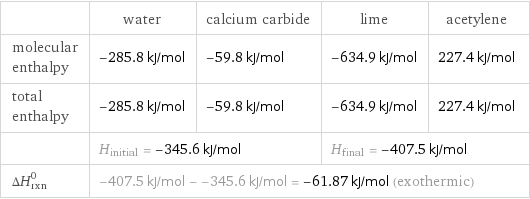
| water | calcium carbide | lime | acetylene molecular enthalpy | -285.8 kJ/mol | -59.8 kJ/mol | -634.9 kJ/mol | 227.4 kJ/mol total enthalpy | -285.8 kJ/mol | -59.8 kJ/mol | -634.9 kJ/mol | 227.4 kJ/mol | H_initial = -345.6 kJ/mol | | H_final = -407.5 kJ/mol | ΔH_rxn^0 | -407.5 kJ/mol - -345.6 kJ/mol = -61.87 kJ/mol (exothermic) | | |
Gibbs free energy
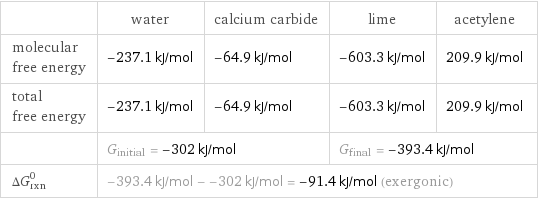
| water | calcium carbide | lime | acetylene molecular free energy | -237.1 kJ/mol | -64.9 kJ/mol | -603.3 kJ/mol | 209.9 kJ/mol total free energy | -237.1 kJ/mol | -64.9 kJ/mol | -603.3 kJ/mol | 209.9 kJ/mol | G_initial = -302 kJ/mol | | G_final = -393.4 kJ/mol | ΔG_rxn^0 | -393.4 kJ/mol - -302 kJ/mol = -91.4 kJ/mol (exergonic) | | |
Entropy
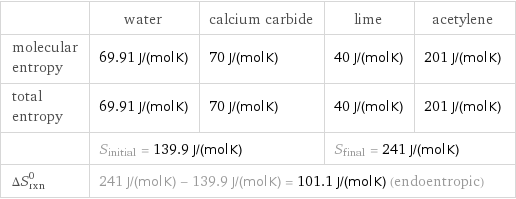
| water | calcium carbide | lime | acetylene molecular entropy | 69.91 J/(mol K) | 70 J/(mol K) | 40 J/(mol K) | 201 J/(mol K) total entropy | 69.91 J/(mol K) | 70 J/(mol K) | 40 J/(mol K) | 201 J/(mol K) | S_initial = 139.9 J/(mol K) | | S_final = 241 J/(mol K) | ΔS_rxn^0 | 241 J/(mol K) - 139.9 J/(mol K) = 101.1 J/(mol K) (endoentropic) | | |
Equilibrium constant
![Construct the equilibrium constant, K, expression for: H_2O + CaC_2 ⟶ CaO + C_2H_2 Plan: • Balance the chemical equation. • Determine the stoichiometric numbers. • Assemble the activity expression for each chemical species. • Use the activity expressions to build the equilibrium constant expression. Write the balanced chemical equation: H_2O + CaC_2 ⟶ CaO + C_2H_2 Assign stoichiometric numbers, ν_i, using the stoichiometric coefficients, c_i, from the balanced chemical equation in the following manner: ν_i = -c_i for reactants and ν_i = c_i for products: chemical species | c_i | ν_i H_2O | 1 | -1 CaC_2 | 1 | -1 CaO | 1 | 1 C_2H_2 | 1 | 1 Assemble the activity expressions accounting for the state of matter and ν_i: chemical species | c_i | ν_i | activity expression H_2O | 1 | -1 | ([H2O])^(-1) CaC_2 | 1 | -1 | ([CaC2])^(-1) CaO | 1 | 1 | [CaO] C_2H_2 | 1 | 1 | [C2H2] The equilibrium constant symbol in the concentration basis is: K_c Mulitply the activity expressions to arrive at the K_c expression: Answer: | | K_c = ([H2O])^(-1) ([CaC2])^(-1) [CaO] [C2H2] = ([CaO] [C2H2])/([H2O] [CaC2])](../image_source/ae3b0d1948fec4021ecd73a9b7abfaec.png)
Construct the equilibrium constant, K, expression for: H_2O + CaC_2 ⟶ CaO + C_2H_2 Plan: • Balance the chemical equation. • Determine the stoichiometric numbers. • Assemble the activity expression for each chemical species. • Use the activity expressions to build the equilibrium constant expression. Write the balanced chemical equation: H_2O + CaC_2 ⟶ CaO + C_2H_2 Assign stoichiometric numbers, ν_i, using the stoichiometric coefficients, c_i, from the balanced chemical equation in the following manner: ν_i = -c_i for reactants and ν_i = c_i for products: chemical species | c_i | ν_i H_2O | 1 | -1 CaC_2 | 1 | -1 CaO | 1 | 1 C_2H_2 | 1 | 1 Assemble the activity expressions accounting for the state of matter and ν_i: chemical species | c_i | ν_i | activity expression H_2O | 1 | -1 | ([H2O])^(-1) CaC_2 | 1 | -1 | ([CaC2])^(-1) CaO | 1 | 1 | [CaO] C_2H_2 | 1 | 1 | [C2H2] The equilibrium constant symbol in the concentration basis is: K_c Mulitply the activity expressions to arrive at the K_c expression: Answer: | | K_c = ([H2O])^(-1) ([CaC2])^(-1) [CaO] [C2H2] = ([CaO] [C2H2])/([H2O] [CaC2])
Rate of reaction
![Construct the rate of reaction expression for: H_2O + CaC_2 ⟶ CaO + C_2H_2 Plan: • Balance the chemical equation. • Determine the stoichiometric numbers. • Assemble the rate term for each chemical species. • Write the rate of reaction expression. Write the balanced chemical equation: H_2O + CaC_2 ⟶ CaO + C_2H_2 Assign stoichiometric numbers, ν_i, using the stoichiometric coefficients, c_i, from the balanced chemical equation in the following manner: ν_i = -c_i for reactants and ν_i = c_i for products: chemical species | c_i | ν_i H_2O | 1 | -1 CaC_2 | 1 | -1 CaO | 1 | 1 C_2H_2 | 1 | 1 The rate term for each chemical species, B_i, is 1/ν_i(Δ[B_i])/(Δt) where [B_i] is the amount concentration and t is time: chemical species | c_i | ν_i | rate term H_2O | 1 | -1 | -(Δ[H2O])/(Δt) CaC_2 | 1 | -1 | -(Δ[CaC2])/(Δt) CaO | 1 | 1 | (Δ[CaO])/(Δt) C_2H_2 | 1 | 1 | (Δ[C2H2])/(Δt) (for infinitesimal rate of change, replace Δ with d) Set the rate terms equal to each other to arrive at the rate expression: Answer: | | rate = -(Δ[H2O])/(Δt) = -(Δ[CaC2])/(Δt) = (Δ[CaO])/(Δt) = (Δ[C2H2])/(Δt) (assuming constant volume and no accumulation of intermediates or side products)](../image_source/0842f62439ea6117210161d3ca65381b.png)
Construct the rate of reaction expression for: H_2O + CaC_2 ⟶ CaO + C_2H_2 Plan: • Balance the chemical equation. • Determine the stoichiometric numbers. • Assemble the rate term for each chemical species. • Write the rate of reaction expression. Write the balanced chemical equation: H_2O + CaC_2 ⟶ CaO + C_2H_2 Assign stoichiometric numbers, ν_i, using the stoichiometric coefficients, c_i, from the balanced chemical equation in the following manner: ν_i = -c_i for reactants and ν_i = c_i for products: chemical species | c_i | ν_i H_2O | 1 | -1 CaC_2 | 1 | -1 CaO | 1 | 1 C_2H_2 | 1 | 1 The rate term for each chemical species, B_i, is 1/ν_i(Δ[B_i])/(Δt) where [B_i] is the amount concentration and t is time: chemical species | c_i | ν_i | rate term H_2O | 1 | -1 | -(Δ[H2O])/(Δt) CaC_2 | 1 | -1 | -(Δ[CaC2])/(Δt) CaO | 1 | 1 | (Δ[CaO])/(Δt) C_2H_2 | 1 | 1 | (Δ[C2H2])/(Δt) (for infinitesimal rate of change, replace Δ with d) Set the rate terms equal to each other to arrive at the rate expression: Answer: | | rate = -(Δ[H2O])/(Δt) = -(Δ[CaC2])/(Δt) = (Δ[CaO])/(Δt) = (Δ[C2H2])/(Δt) (assuming constant volume and no accumulation of intermediates or side products)
Chemical names and formulas
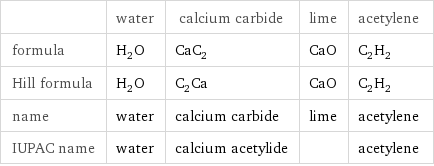
| water | calcium carbide | lime | acetylene formula | H_2O | CaC_2 | CaO | C_2H_2 Hill formula | H_2O | C_2Ca | CaO | C_2H_2 name | water | calcium carbide | lime | acetylene IUPAC name | water | calcium acetylide | | acetylene